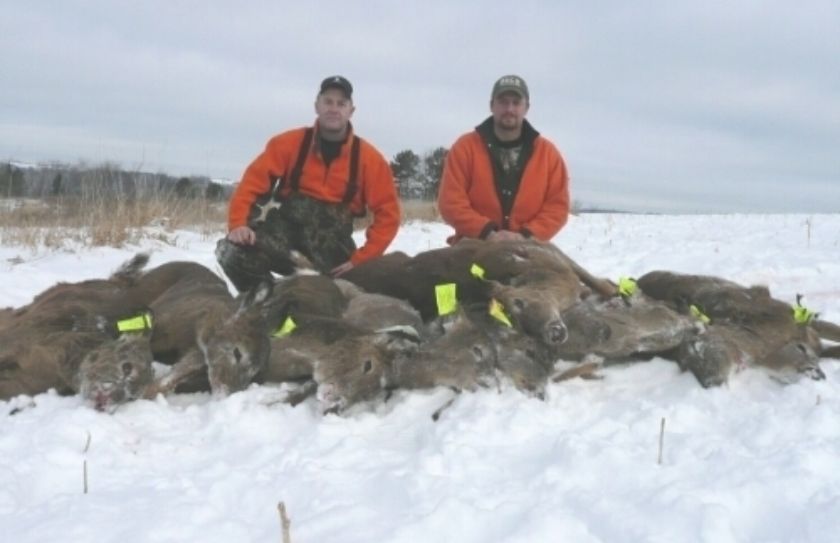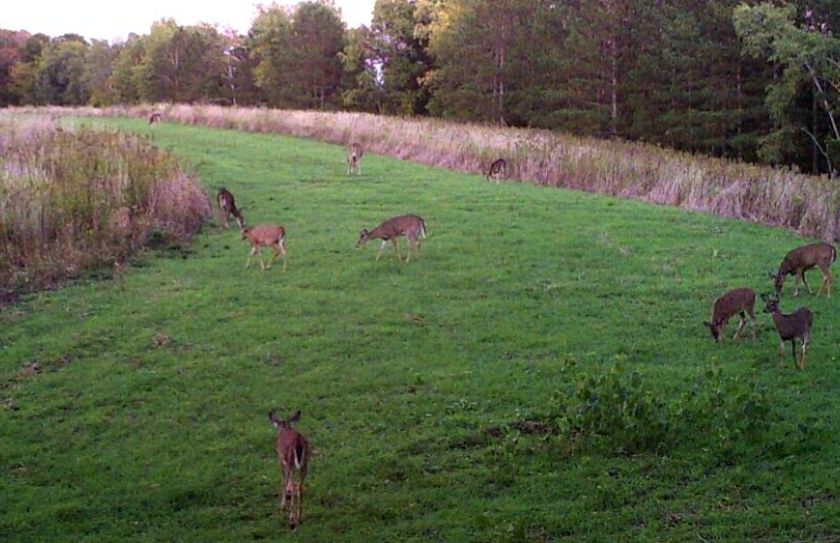Seasoned deer managers are beginning to realize that too much of a good thing is a bad thing, when it comes to whitetail management, and one of the greatest risks is in creating doe factory habitat.
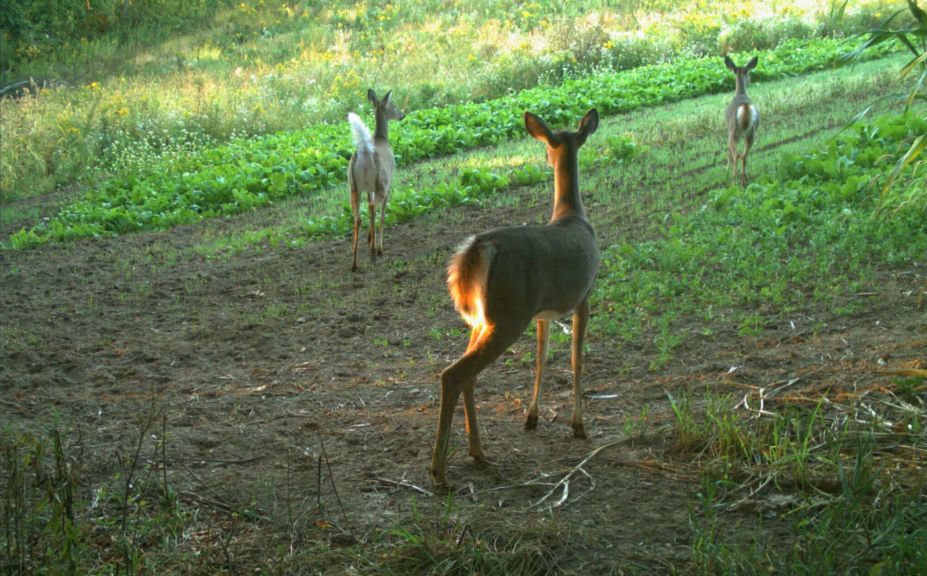
Doe Factory Habitat Definition:
The risk of creating an overabundance of Summer fawning cover. Herd building through antlerless deer expansion. Habitat conducive to rapid population expansion through extremely high levels of Summer fawning conditions. The combination of quality habitat improvements to artificially increase doe population levels
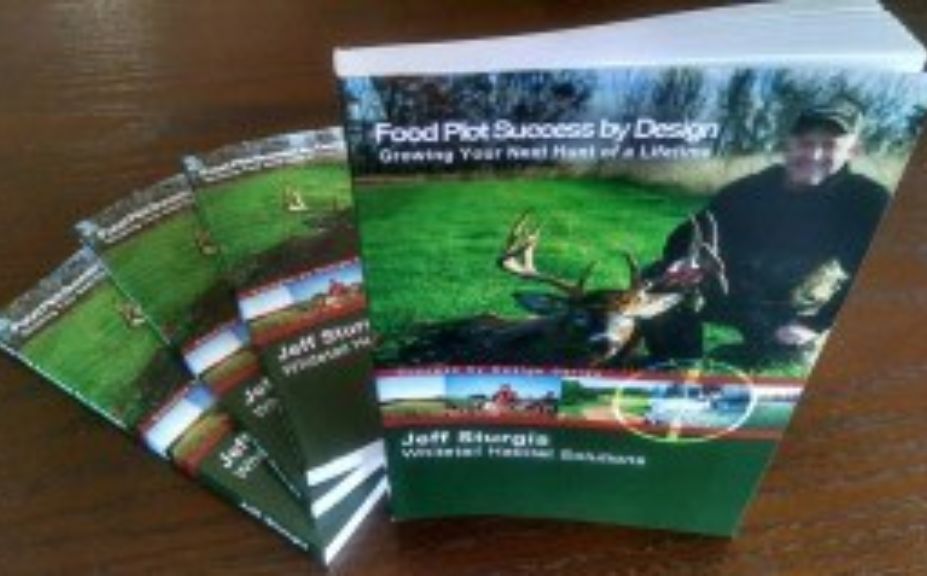
*Don’t forget to check out my trilogy of Advanced Whitetail Strategy books, including my food plot strategy book,“Food Plot Success by Design”.
Are you infected with doe factory habitat?
The first step to recovery is admitting that there is a problem. The risk of creating doe factory habitat is real, and it is more common than ever. The symptoms of the condition can be present anywhere that whitetail habitat enthusiasts and whitetails are combined. Here are 5 symptoms that may reveal your habitat has succomb to the risks of creating a doe factory:
1. Summer doe populations on your land, that are greater than the neighborhood average.
-Summer does are here to stay. If you have the greatest number of does on your land during the Summer months, you can bet unless you cut the Fall food or spook the herd off the land, you will carry the highest number of antleless deer during the hunting season.
2. A higher percentage of nocturnal hunting season mature buck movements, than daytime movements.
-Doe family groups take up space. Mature bucks avoid stress, and that not only includes hunter related stressors, but high levels of social stress as well. It is very easy to create a parcel that literally that has no room leftover for bucks, in particular as they increase in age. Your buck hunting is left to a possible early archery encounter or two before bucks shift to their preferred Fall habitat, during the peak of the rut when bucks leave their core areas to continue the rut, or during the late season when food sources and quality cover options have been significantly reduced within the neighborhood.
3. A never ending annual vaccum of population numbers.
-20 does are replaced by 20 does. -Quality Summer fawning grounds are highly competitive between doe family groups, let alone the dominant females of the herd. Subordinate fringe does eventually become resident full-timers, after their competition has been successfully removed.
4. Difficulty in obtaining population control through traditional hunting methods.
-It can resemble a giant sucking noise. 10 does are removed, and 10 does take their place the next year. 30 are removed, and 30 take their place through fawning and habitat shifting. While your neighbors may be scratching their heads and having a tough time harvesting a single doe, let alone 5 or more, you have absolutely no problem harvesting a dozen or more. It seems that you can’t find enough tags.
5. Poor doe to buck harvest ratios.
-A common ratio of well managed whitetail parcels, to maintain a stable, base, appropriate number of does, is: 2 antlerless harvests for every buck killed on your land. If it is necessary for you to shoot 5 does for every buck or higher, you most likely have a huge, doe factory habitat problem.
Doe Factory Habitat Management Concerns: Have you heard of the Waupaca County, WI problem? Excessive doe numbers may unwittingly force the closure of buck season for 2016. I personally believe that the plan will most likely backfire, as hunters may prefer to spend their time hunting bucks’s elsewhere, which could actually lead to increasing population numbers, instead of decreasing them. However there is definitely a feast or famine harvest ratio problem within the area, as evidenced by a portion of this disgruntled landowner’s email, who wrote, “I have taken 314 antlerless and 70 bucks 5 miles from *****’s place the last 10 years. ***** has taken maybe 30 doe.”
Nearly a 4.5:1 doe to buck harvest ratio over a 10 year period, is a strong indication of a doe factory habitat problem. However, the email is also reflective of the potential feast and famine nature for concentrated pockets of highly established doe factories, which often stems from the diminutive nature of doe family group home ranges.
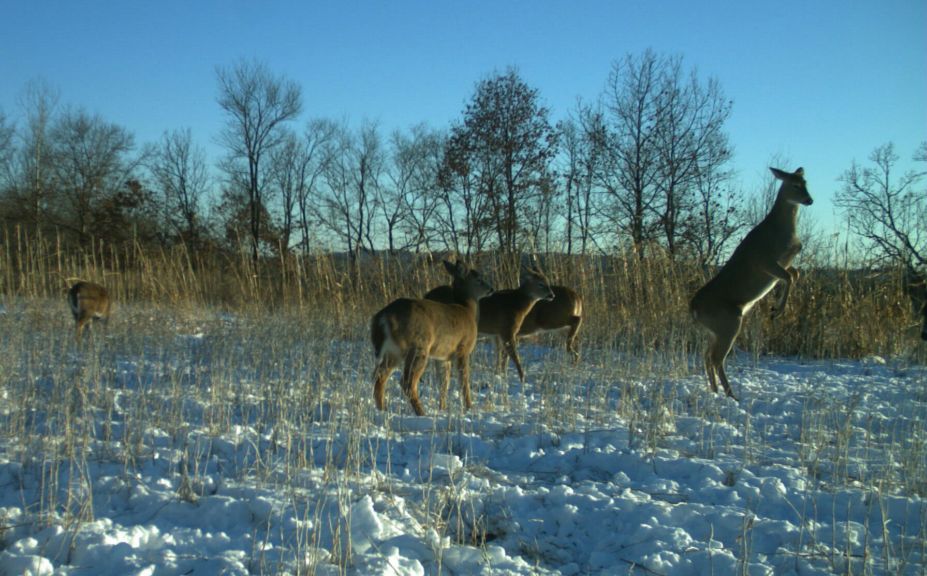
*Doe factory habitat can create a highly stressed, unstable population of a continuosly competing antlerless deer herd. Are you experiencing a vaccum of annually regenerating doe numbers? Then make sure to apply the harvest strategies found by reading, “Easy Doe Hunting Equals Herd Success”.
Summer Does Are Here To Stay:
Antlerless deer have much smaller home ranges than bucks. They are homebodies. I have witnessed various doe family groups on numerous parcels, that appear to live within a 200-300 yard home range, the entire hunting season. But doe family groups not only require space, but they certainly rule the roost when it comes to outcompeting bucks looking for a place to call home, during the daytime hours. This may not seem like a big deal, afterall, attract the ladies and the boys will follow; right? Well, not exactly. Sure, mature bucks will gravitate to heavy doe populations at some point during the rut, but that is a very limited window. Also, if those bucks are traveling from adjacent lands to find receptive does on your parcel, you can count on them spending a lot more time off of your land during the daylight, than on your land. Hence, the higher % of nocturnal mature buck photos, than daytime pictures. But a loss of quality hunting and daytime trail cam opportunities are only the beginning!
As a lifetime member of the Quality Deer Management Association (QDMA), I strictly adhere and strive for, the biological basis of QDM, which includes: Populations maintained in balance with the habitat, appopriate sex ratios and adequate buck age structures. That doesn’t mean you are attempting to have very few deer and only shoot bucks when they are at their peak of antler growth, but instead that you are attempting to create balance in your herd, hunting and habitat efforts. But regardless of what you feel about the QDMA or even the biological basics of QDM, you will never find balance if you are creating doe factory habitat conditions, because Summer does are here to stay.
Increasing Doe Factory Habitat Decreases Herd and Hunting Potential: The parcel with the most does during the season is not the parcel that molds and shapes the deer herd in the neighborhood. Instead, those parcels are often more of the problem, than the solution. By creating a sucking vaccum of an ever regenerating, over-population of antlerless deer, those does are exposed to fewer hunters per season, resulting in excessively high numbers within the neighborhood. Doe harvest becomes “feast or famine”; feast for a few and famine for most. The results can be extremely negative to not only neighboring hunters, but for the effort of creating the base biological balance of QDM.
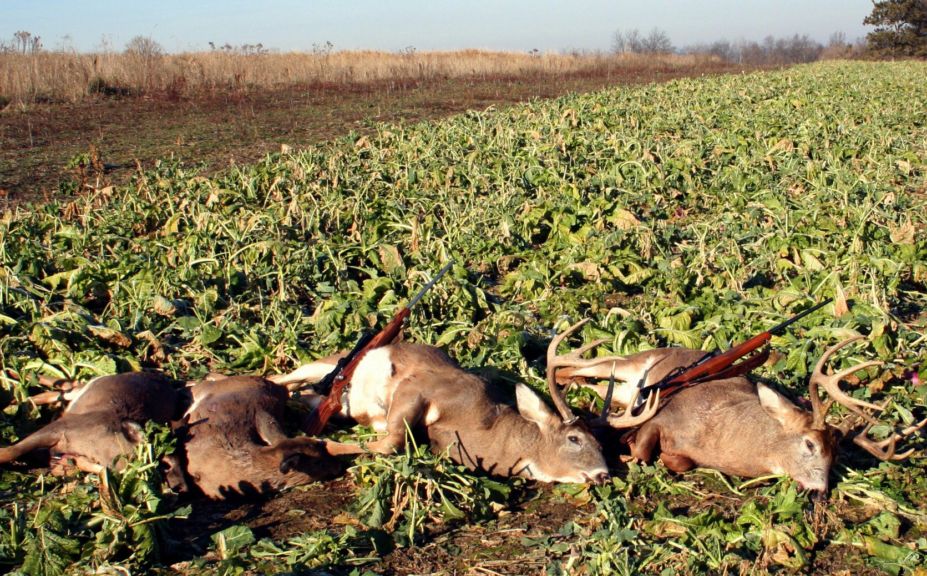
A balanced herd creates balanced harvest opportunities, but your hunting efforts need to be up to the challenge. To make sure you hunting tactics are on pace with your herd management goals, make sure to check out, "8 Low Impact Mature Buck Hunting Tactics"
How Can You Avoid Doe Factory Habitat? Avoiding a doe factory = balance. Balance in habitat offerings, balance in sex ratios, balance buck age structure and balance in population numbers. Doe family groups can tolerate a much higher level of stress, than a seasoned old monarch. When you combine excessive levels of Summer doe factory habitat and poor hunting practices, the table is set for you to experience incredibly high populations of antlerless deer throughout the entire year. Here are 5 ways to work towards balance, no matter if your numbers are too high, or too low:
1. Summer Food Control
-If your numbers are too low, add Summer food to build a balanced herd, and then slowly reduce to the number of acres needed during the Summer, to maintain a stable population. Excess food only magnifies the Summer attraction to unnatural levels, leaving you vulnerable to creating a doe factory. If you have poor doe to buck harvest ratios and excessive Summer antlerless deer numbers, work slowly to reduce Summer food while at the same time expanding your antlerless harvest efforts. In the UP of MI I initially used 8 acres of Summer clover rotated within Fall annual plantings to build a herd, and then slowly reduced the Summer clover acreage to an acre when it was time to stabelize a balanced population number.
2. Precision Doe Harvest Tactics
-When I lived and owned land in a Southern MI agricultural setting, my neighbors couldn’t stand the deer. The deer ate their corn, beans, hay and effected their chosen lifestyle. Their answer? Fill the fields with hunters and doe tags and shoot any doe that moved, even if it meant shooting across property lines. In 2007 they killed 1 doe and 7 button bucks on opening day. Following a light snow the next day, not a single track could be found in the section, as the deer migrated to a doe factory across the road. You will find that less is more when it comes to doe harvest too! By using specific days to harvest does during low-impact portions of the season (early youth, Summer crop damage, opportunistic early bow, Dec and Jan does seasons, late bow), you can find that you can achieve high harvest numbers during a few hours with a select number of individuals dedicated towards strategically targeting an unsuspecting deer herd. The middle of the season (opening day of gun season in many States) is the worst time to target an already highly stressed deer herd.
3. Limit Habitat Improvements
-This may seem counterproductive, but if every square inch of your land is improved, you will be left with no way to access your stand locations without a high probability of spooking deer. Instead, make sure that your improvements work in harmony within a coohesive pattern of highly defined daily deer movement opportunity. Buck bedding should compliment doe bedding which should then combine with secure travel to afternoon food sources, while matching the topography, exterior influences and major habitat changes. Depending on the size or your parcel, available road access and water sources, between 20% and 50% of your land should be dedicated to moderate quality habitat offerings, or lower. The remaining 50-80% of the land that is improved, should be highly defined enough to allow you to slip in an out of stand locations more than 1 way, so that you can move through and around your land like the giant advanced predator that you should be.
4. Season Specific Improvement Focus
-Unless you have close to 1000 acres or more, you will devalue the effectivess of your land if you attempt to manage a deer population for 365 days per year. Does it really matter if the neighborhood migrate to your neighbor’s conifer thermal protection habitat adjacent to a standing corn field during the Winter? What about if the local deer herd dines on the 1000s of acres of beans and manicured hay fields during the Summer that surround your land? Or in Northern extreme cases, do you need to attempt to “outcompete” the Hardwood timber harvest operations during the Spring, Summer and Early Fall, that provide quality Summer browse, cooler temps and a prolific number of stems per acre of hardwood regen for high quality fawning cover? The answer is a solid “No” to all 3, because the deer can do just fine without landowners attempting to jam them into concentrated Summer offerings at levels that are unnatural. This is particularily important, when it is quite evident that those efforts can be detrimental for maintaining population control, or achieving balanced sex ratio and buck age structure numbers. Instead, try hitting the leanest, most critical times of the year that allow you to mold and shape the herd in balance with the habitat. That means creating food and cover sources when the local habitat is dying instead of thriving, and by offering a low-stress refuge when neighboring stressors are at their worst.
5. Hunt Smart
-A balanced parcel should offer quality hunting opportunities all season long. Not just during the bow season opener or during the peak of the rut. By hunting with your access and wind direction on your side, by creating highly defined daytime deer movement and by allowing 50-80% of your land to house and feed the deer herd without any hunting season intrusions, you will have accomplished a combination of herd and hunting results that is major accomplishment.
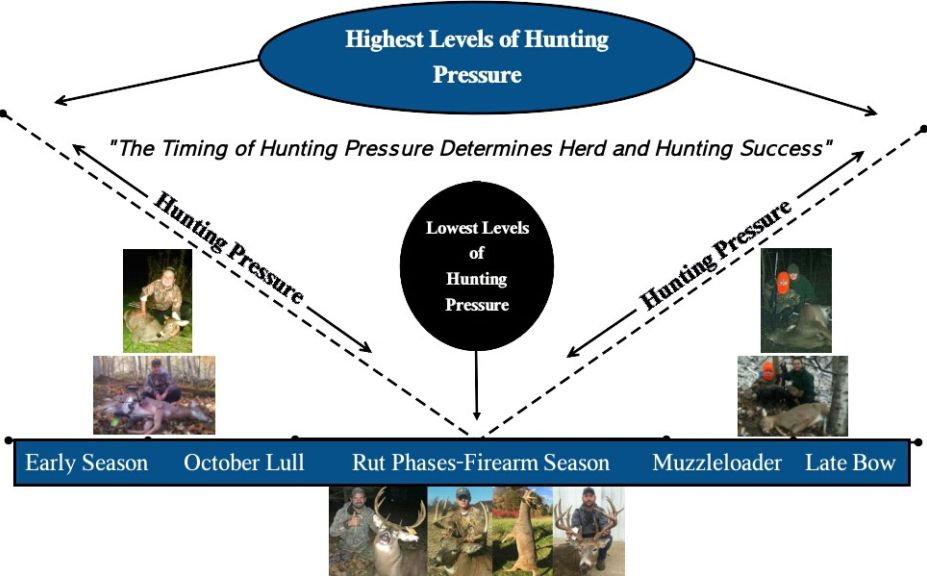
*Hunting smart also includes knowing when to target antlerless deer and when to sit back and allow your land to become a refuge. To help you find this balance, check out the tips in, “Important Deer Hunting Pressure Control Tactic”
Creating doe factory habitat problems is a realistic threat towards expanding deer herds in various locations of the country. While some areas of the whitetail range are far too lean, other areas are busting at the seams. The Waupaca County WI area is a magnet for whitetail habitat management and high end hunting opportunity, and also pocketsbof high doe concentrations. Hunters who shoot more than their fair share of does blame those who don’t, but the root of the problem is likely much, much deeper than that. From personal experience I know that doe factory habitat is rampant in the area. It is a potential recipe for disastor! Landowners create doe factory habitat conditions and shoot sometimes dozens of does per year. Local wildlife officials take drastic measures by eliminating buck harvest opportunities. Hunters who travel to their their lands in the area will then choose to spend the majority of their time elsewhere to hunt bucks, and some of those well established doe factory conditions will actually increase, to the surprise of unsuspecting well meaning landowners and wildlife officials. However, change can happen!
By controling when food is available to local deer herds and practicing advanced herd and hunting tactics, landowners can find the necessary balance that they desire. In life less is often more, and in the effort of creating deer habitat for quality deer herds and hunting opportunities, that rule could not apply more. If you have created a doe factory you are not alone, but by first admitting there could be a potential problem, you can be well on your way to herd, hunting and habitat recovery.

